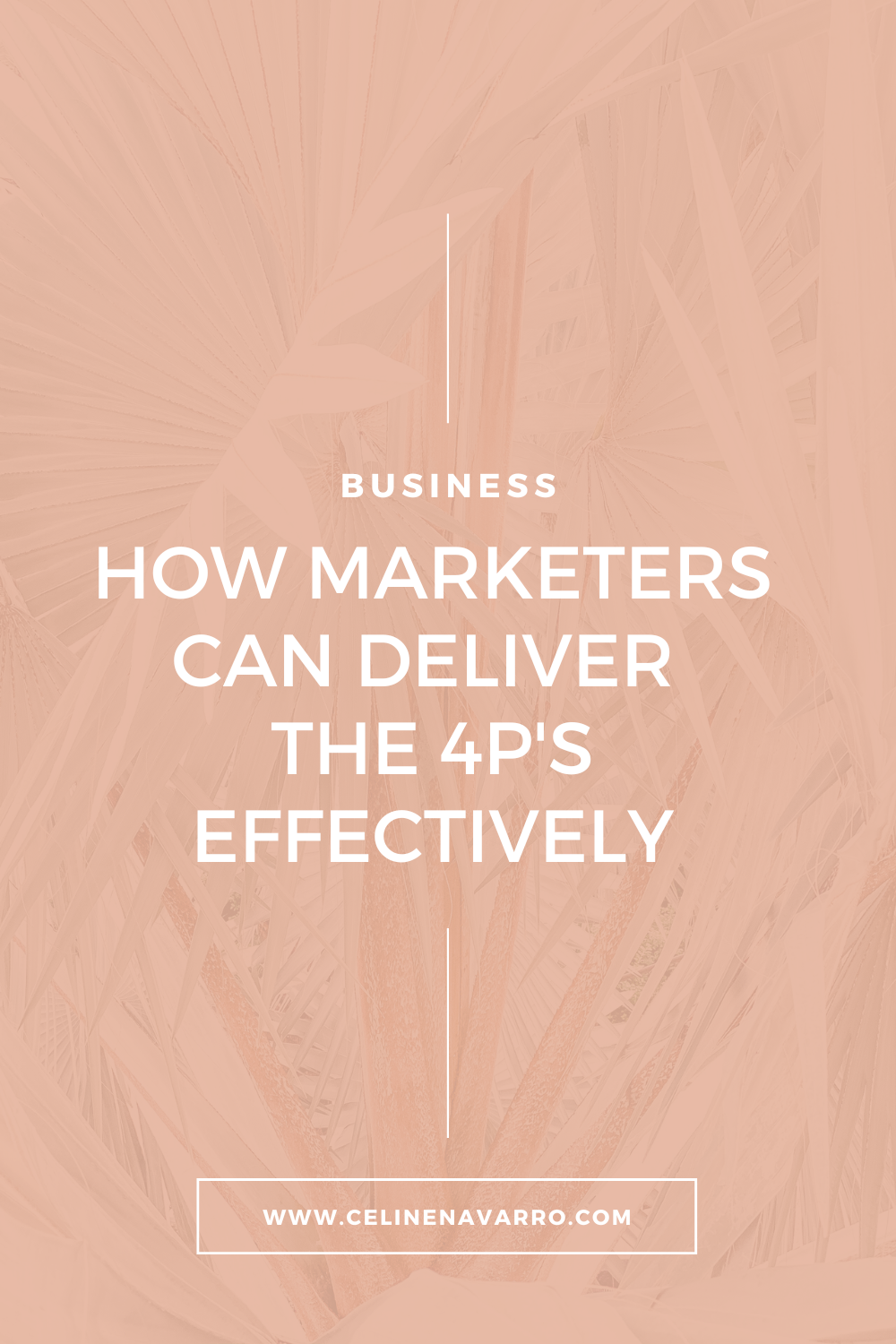HOW MARKETERS CAN DELIVER THE 4P'S EFFECTIVELY
Though we may have been taught about the 4 P's of marketing in school, it's quickly apparent that there's more to learn to be effective in the real world. However, one thing remains unchanged - the importance of delivering these critical components to your audience. As a marketer or manager, it's essential to understand how to deliver the 4 Ps effectively and efficiently.
Via Pexels
Define Your Target Market
When defining a target market for any product or service, it is essential to consider the customers' needs and wants and audience demographics. Knowing who you are targeting and why is key to creating effective strategies that will help bring in quality leads and sales. For example, knowing if you're targeting college-aged individuals in an urban area versus retirees in a rural area can impact how you design marketing materials to appeal to both populations. Creative campaigns built with thoughtful consideration usually result in higher engagement rates with your target market, helping create the maximum possible return on your marketing investments.
Create A Unique Selling Proposition
Creating a unique selling proposition is essential for any business looking to attract and retain customers. It's all about setting yourself apart from the competition. Taking a step back and evaluating what makes you different or better than your rivals can help create a marketing angle that resonates with the target audience. Steps for creating a unique selling proposition include:
1. Understand Your Customer - What are the customer's needs and wants? What problems does your product or service solve for them?
2. Analyze The Competition - Who is offering similar solutions to yours? How can you differentiate yourself from them?
3. Develop A Unique Benefit Statement - Craft a statement that communicates what sets your business apart from rivals.
4. Test And Tweak - Monitor responses to your unique benefit statement and make necessary adjustments.
Develop An Effective Pricing Strategy
When developing an effective pricing strategy, several key questions must be considered. How will the price point compare to competitors? Will you offer discounts for volumes? Have you considered production and marketing costs when coming up with a number? Your pricing needs to be just enough to profit while remaining competitive in the market. Getting this balance right is essential for the success of your business. Here are some tips to consider when creating a pricing strategy:
1. Research the market - Understand what your competitors charge for similar services or products.
2. Determine the customer value - What is the perceived value of your product or service? Are there any unique features that could help you charge more?
3. Monitor customer feedback - Keep an eye on feedback and adjust prices to remain competitive.
4. Test different pricing options - Experiment with different price points to identify which works best for your product/service.
5. Consider a bundle approach - Offering discounts for multiple items or services can significantly increase sales.
6. Reevaluate periodically - Review your pricing model every few months to ensure it's still relevant.
Promote Your Product Or Service Using Various Marketing Channels
Promoting a business' product or service requires a strategic approach and understanding of multi-channel efforts that utilize online, offline, and word-of-mouth marketing. Optimizing a business' promotional capabilities to capitalize on such diverse tactics helps ensure maximum visibility for its product or service and creates a well-rounded marketing plan. Through utilizing multiple marketing channels, businesses gain the capacity to capture larger, more diverse customers, which can ultimately lead to increased success and profitability. A vital element of this process is ensuring any content produced is consistent across all channels to maintain a company's brand reputation while effectively reaching its target audience. Different marketing channels in 2023 that must be explored include the following:
1. Social Media - Utilizing platforms such as Facebook, Twitter, and Instagram to build brand awareness and engage with potential customers.
2. Paid Advertising - Platforms like Google Ads and Bing Ads can help increase conversions by reaching a broader audience.
3. Influencer Marketing - Partnering with influencers or celebrities to create sponsored content around your product/service.
4. Email Marketing - Send emails to current and potential customers to keep them informed of promotions and updates.
5. 3-D Augmented Reality - Bringing your product to life through 3-D augmented reality can provide a unique experience for potential customers.
6. Video Marketing - Videos are still an incredibly powerful form of marketing that allows you to showcase products/services and engage with customers.
7. Live Events - Host live events to interact directly with customers and create a buzz around your product/service.
8. Omnichannel Marketing - Utilizing multiple channels to deliver a consistent, unified message and experience.
Via Pexels
Develop an Effective Distribution Strategy
Once you have developed an effective pricing strategy and promotional plan, it's time to determine how you will get your product or service into the hands of your target market. Distribution refers to the process by which products and services are delivered from their source through various channels such as distributors, resellers, wholesalers, and retailers. Therefore, businesses need to understand the different distribution channels available to most effectively get their product/service into the hands of their target customers.
1. Direct Distribution - Delivering products/services directly to consumers without going through a third-party reseller.
2. Indirect Distribution - Utilizing distributors and retailers to deliver products/services to consumers.
3. Combination Strategies - Utilizing a combination of direct and indirect distribution strategies depending on your product/service.
4. E-commerce Platforms - Leveraging e-commerce platforms such as Amazon and eBay to reach potential customers.
5. In-house Logistics - Utilizing fleet drivers for local delivery of products/services can be an effective option for businesses managing a small to medium-sized fleet. It might be daunting managing fleet drivers, but there are several software solutions available to help streamline the process.
6. Third-Party Logistics - Partnering with third-party logistics companies such as FedEx and UPS can be useful for businesses managing larger fleets of drivers to ensure on-time delivery and customer satisfaction. Also, it helps companies save time and money.
7. Wholesalers/Distributors - Utilizing wholesale and distribution networks can help companies reach larger, more geographically diverse markets.
Evaluate Your Results Regularly And Adjust Accordingly
When the 4Ps are managed well, they can help create strong customer loyalty and repeat purchases. However, it is essential to remember that marketing is constantly changing, so marketers must continually evaluate their results and adjust their strategy accordingly to maximize success. By leveraging data analytics tools such as Google Analytics and Kissmetrics, marketers can track website user behavior and understand what customers are responding to optimize their campaigns for maximum impact. Additionally, by continuously testing different strategies, marketers can stay ahead of the competition by keeping up with new trends and industry best practices.
By effectively managing the 4Ps (Product, Price, Promotion & Place), marketers can positively impact their target audience and drive sales. By following the steps outlined above, marketers can develop an effective strategy to ensure that their products/services reach the right customers with the right message at the right time. It is crucial for marketers to continually evaluate and adjust their strategies to stay ahead of competitors and maximize success.
In conclusion, a 4P framework is excellent for marketers looking to engage their target market and increase sales. Marketers can gain a competitive edge by following these steps and leveraging available resources in today's ever-changing business climate. With careful planning and consideration, businesses can create powerful marketing campaigns that will effectively reach their desired audiences while meeting their overall objectives. Ultimately, by considering all these factors, businesses can set themselves up for success in today's competitive marketplace.



